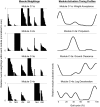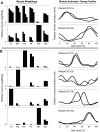Modular control of varied locomotor tasks in children with incomplete spinal cord injuries
- PMID: 23761702
- PMCID: PMC3763159
- DOI: 10.1152/jn.00676.2012
Modular control of varied locomotor tasks in children with incomplete spinal cord injuries
Abstract
A module is a functional unit of the nervous system that specifies functionally relevant patterns of muscle activation. In adults, four to five modules account for muscle activation during walking. Neurological injury alters modular control and is associated with walking impairments. The effect of neurological injury on modular control in children is unknown and may differ from adults due to their immature and developing nervous systems. We examined modular control of locomotor tasks in children with incomplete spinal cord injuries (ISCIs) and control children. Five controls (8.6 ± 2.7 yr of age) and five children with ISCIs (8.6 ± 3.7 yr of age performed treadmill walking, overground walking, pedaling, supine lower extremity flexion/extension, stair climbing, and crawling. Electromyograms (EMGs) were recorded in bilateral leg muscles. Nonnegative matrix factorization was applied, and the minimum number of modules required to achieve 90% of the "variance accounted for" (VAF) was calculated. On average, 3.5 modules explained muscle activation in the controls, whereas 2.4 modules were required in the children with ISCIs. To determine if control is similar across tasks, the module weightings identified from treadmill walking were used to reconstruct the EMGs from each of the other tasks. This resulted in VAF values exceeding 86% for each child and each locomotor task. Our results suggest that 1) modularity is constrained in children with ISCIs and 2) for each child, similar neural control mechanisms are used across locomotor tasks. These findings suggest that interventions that activate the neuromuscular system to enhance walking also may influence the control of other locomotor tasks.
Keywords: locomotion; module; spinal cord injury; synergies; walking.
Figures




Similar articles
-
Modularity underlying the performance of unusual locomotor tasks inspired by developmental milestones.J Neurophysiol. 2020 Feb 1;123(2):496-510. doi: 10.1152/jn.00662.2019. Epub 2019 Dec 11. J Neurophysiol. 2020. PMID: 31825715
-
Neuromuscular constraints on muscle coordination during overground walking in persons with chronic incomplete spinal cord injury.Clin Neurophysiol. 2014 Oct;125(10):2024-35. doi: 10.1016/j.clinph.2014.02.001. Epub 2014 Feb 14. Clin Neurophysiol. 2014. PMID: 24618214 Free PMC article.
-
Motor module activation sequence and topography in the spinal cord during air-stepping in human: Insights into the traveling wave in spinal locomotor circuits.Physiol Rep. 2017 Nov;5(22):e13504. doi: 10.14814/phy2.13504. Physiol Rep. 2017. PMID: 29180480 Free PMC article.
-
Neural plasticity after human spinal cord injury: application of locomotor training to the rehabilitation of walking.Neuroscientist. 2001 Oct;7(5):455-68. doi: 10.1177/107385840100700514. Neuroscientist. 2001. PMID: 11597104 Review.
-
Locomotor training after human spinal cord injury: a series of case studies.Phys Ther. 2000 Jul;80(7):688-700. Phys Ther. 2000. PMID: 10869131 Review.
Cited by
-
Muscle synergies demonstrate only minimal changes after treatment in cerebral palsy.J Neuroeng Rehabil. 2019 Mar 29;16(1):46. doi: 10.1186/s12984-019-0502-3. J Neuroeng Rehabil. 2019. PMID: 30925882 Free PMC article.
-
Patient-specific functional electrical stimulation strategy based on muscle synergy and walking posture analysis for gait rehabilitation of stroke patients.J Int Med Res. 2021 May;49(5):3000605211016782. doi: 10.1177/03000605211016782. J Int Med Res. 2021. PMID: 34038206 Free PMC article.
-
Kinematic and Neuromuscular Adaptations in Incomplete Spinal Cord Injury after High- versus Low-Intensity Locomotor Training.J Neurotrauma. 2019 Jun 15;36(12):2036-2044. doi: 10.1089/neu.2018.5900. Epub 2019 Feb 1. J Neurotrauma. 2019. PMID: 30362878 Free PMC article. Clinical Trial.
-
Recent developments in muscle synergy analysis in young people with neurodevelopmental diseases: A Systematic Review.Front Bioeng Biotechnol. 2023 Apr 27;11:1145937. doi: 10.3389/fbioe.2023.1145937. eCollection 2023. Front Bioeng Biotechnol. 2023. PMID: 37180039 Free PMC article. Review.
-
Walking speed is not the best outcome to evaluate the effect of robotic assisted gait training in people with motor incomplete Spinal Cord Injury: A Systematic Review with meta-analysis.J Spinal Cord Med. 2019 Mar;42(2):142-154. doi: 10.1080/10790268.2017.1390644. Epub 2017 Oct 25. J Spinal Cord Med. 2019. PMID: 29065788 Free PMC article.
References
-
- American Spinal Injury Association Standards for Neurological Classification of Spinal Cord Injury. Chicago, IL: American Spinal Injury Association, 2006
-
- Behrman AL, Harkema SJ. Locomotor training after human spinal cord injury: a series of case studies. Phys Ther 80: 688–700, 2000 - PubMed
-
- Behrman AL, Harkema SJ. Physical rehabilitation as an agent for recovery after spinal cord injury. Phys Med Rehabil Clin N Am 18: 183–202, 2007 - PubMed
-
- Beres-Jones JA, Harkema SJ. The human spinal cord interprets velocity-dependent afferent input during stepping. Brain 127: 2232–2246, 2004 - PubMed
Publication types
MeSH terms
Grants and funding
LinkOut - more resources
Full Text Sources
Other Literature Sources
Medical

